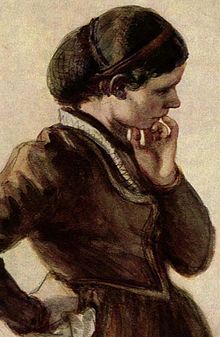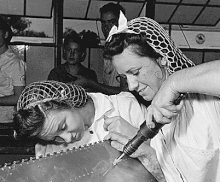Snood (headgear)


A snood (/snuːd/) is a type of traditionally female headgear designed to hold the hair in a cloth or yarn bag.[1] In the most common form, the headgear resembles a close-fitting hood worn over the back of the head. It is similar to a hairnet,[1] but snoods typically have a looser fit,[2] a much coarser mesh, and noticeably thicker yarn. A tighter-mesh band may cover the forehead or crown, then run behind the ears, and under the nape of the neck. A sack of sorts dangles from this band, covering and containing the fall of long hair gathered at the back. A snood sometimes was made of solid fabric, but more often of loosely knitted yarn or other net-like material. Historically (and in some cultures still in use today) a small bag of fine thread—netted, tatted, knitted, crocheted, or knotted (see macramé)—enclosed a bob of long hair on the back of the head or held it close to the nape.[3]
Beard snood[]
Another similar garment which is also referred to as a snood is used to cover facial hair such as beards and moustaches when working in environments such as food production.[4] Although it appears that "hairnet" has replaced "snood" as the common term for hair containment on the head, the term "beard snood" (essentially a "ringed scarf") is still familiar in many food production facilities.
Association football[]
Though popular for many years with European footballers like Gianluigi Buffon—in the 2010–11 Premier League season, a number of high-profile players, including Carlos Tevez and Samir Nasri, wore snoods. The fashion was derided by commentators.[citation needed]
Whereas former Manchester United manager Alex Ferguson said he would no longer allow his players to wear snoods,[5] Arsenal manager Arsène Wenger defended their use, suggesting they serve a medical purpose when players have neck problems in the cold weather.[6]
The International Football Association Board feels that snood scarves may pose a risk to a player's neck if jerked from behind.[7] Players in the UK have been banned from wearing them during matches since 1 July 2011. IFAB had a meeting where the issue was brought up, and they were immediately and completely banned on 5 March 2011, due to not being part of the kit.[8]
Religious use[]
Women's snoods are often worn by married Orthodox Jewish women,[9] according to the religious requirement of hair covering (see Tzniut). Since these snoods are designed to cover the hair more than hold it,[10] they are often lined to prevent them from being see-through. Contemporary hair snoods for Jewish women come in a wide range of colors and designs.[11]
References[]
- ^ Jump up to: a b "History of Hair Covering Part #1: Snoods". Retrieved 5 January 2020.
- ^ Karen Roemuss; Martin Green; Leo Palladino (2018). Professional Hairdressing: Australian and New Zealand Edition (2nd ed.). ISBN 0170415929.
Snoods ... They're like a hair net but have a looser fit and much coarser mesh ...
- ^ Carmenica Diaz (2014). Tales of Aswin. ISBN 129199002X.
- ^ "SmartGuard Beard Snood | | Food Industry Workwear | Disposable Workwear | Protective Workwear | Personal Protective PPE". Protec Direct. Archived from the original on 2012-03-21. Retrieved 2011-09-23.
- ^ "Footballers who wear snoods get it in the neck from Sir Alex Ferguson". Evening Standard. 10 December 2010. Retrieved 5 January 2020.
- ^ "Wenger - Snoods are a medical aid for us". Arsenal F.C. 2010-12-10. Archived from the original on 2011-10-28. Retrieved 2011-09-23.
- ^ "Snoods may be banned in football". BBC Sport. 2011-02-04. Retrieved 2011-09-23.
- ^ Agencies (2011-03-05). "Snoods banned but Fifa to continue goalline technology testing". London: Guardian. Archived from the original on 2013-12-25. Retrieved 2011-09-23.CS1 maint: bot: original URL status unknown (link)
- ^ "Rabbis' Rules and Indian Wigs Stir Crisis in Orthodox Brooklyn". NYTimes.com. May 14, 2004.
- ^ Silver, Rivki (5 February 2012). "Me and My Covered Hair, Part Two: Tichels, Hats and More". Retrieved 5 January 2020.
- ^ "Snoods VS. Sheitels". Retrieved 5 January 2020.
- 1860s fashion
- 1870s fashion
- 1940s fashion
- Fashion accessories
- Headgear
- History of clothing (Western fashion)
- Hoods (headgear)
- Jewish religious clothing
